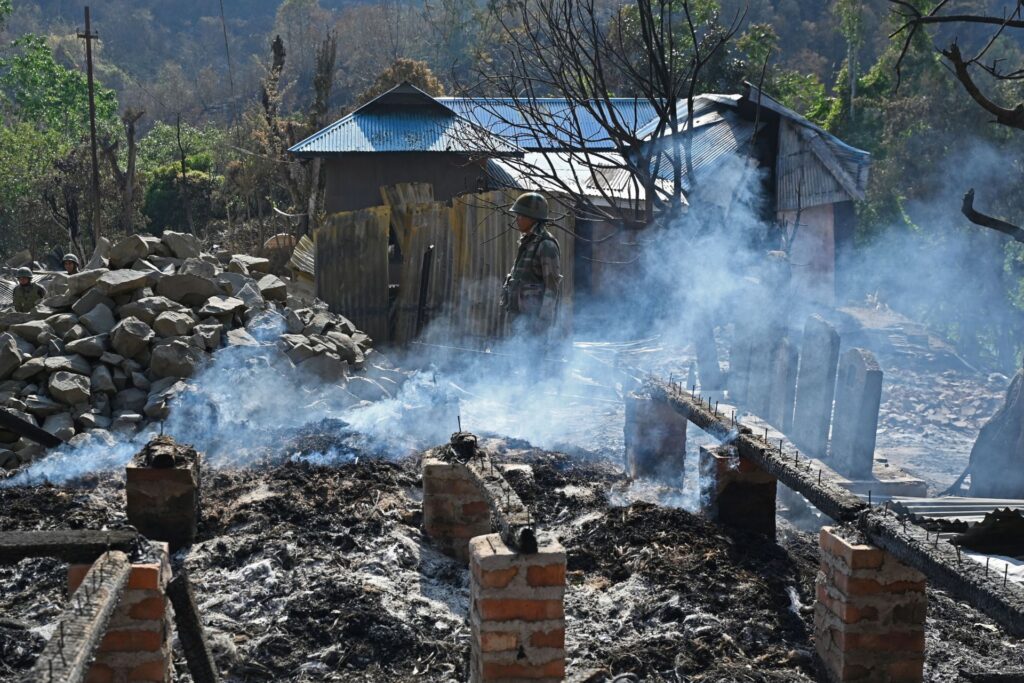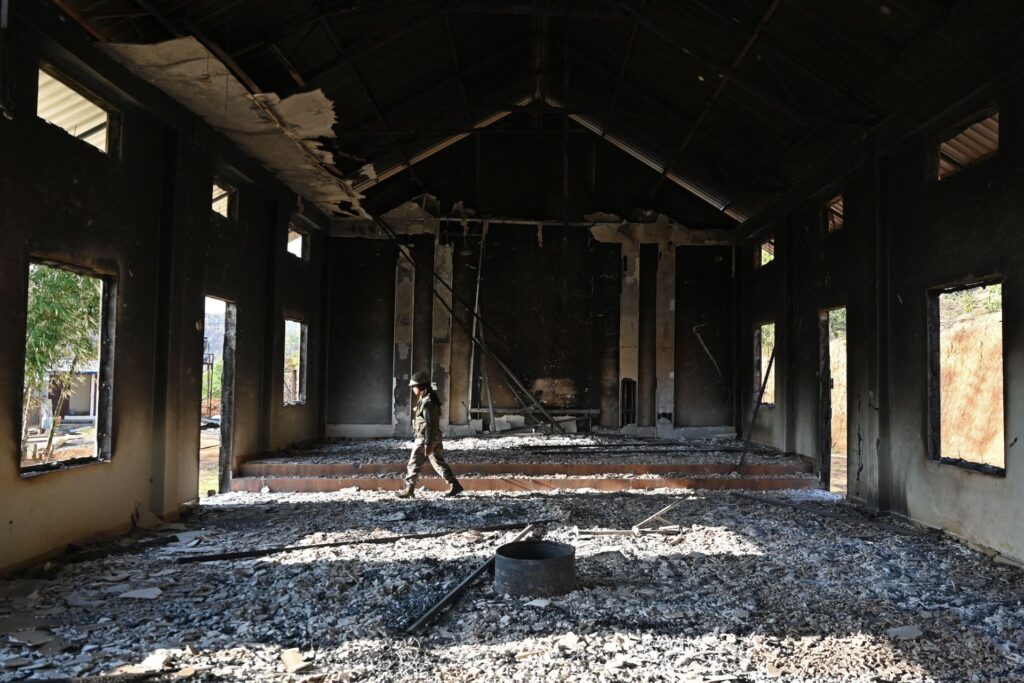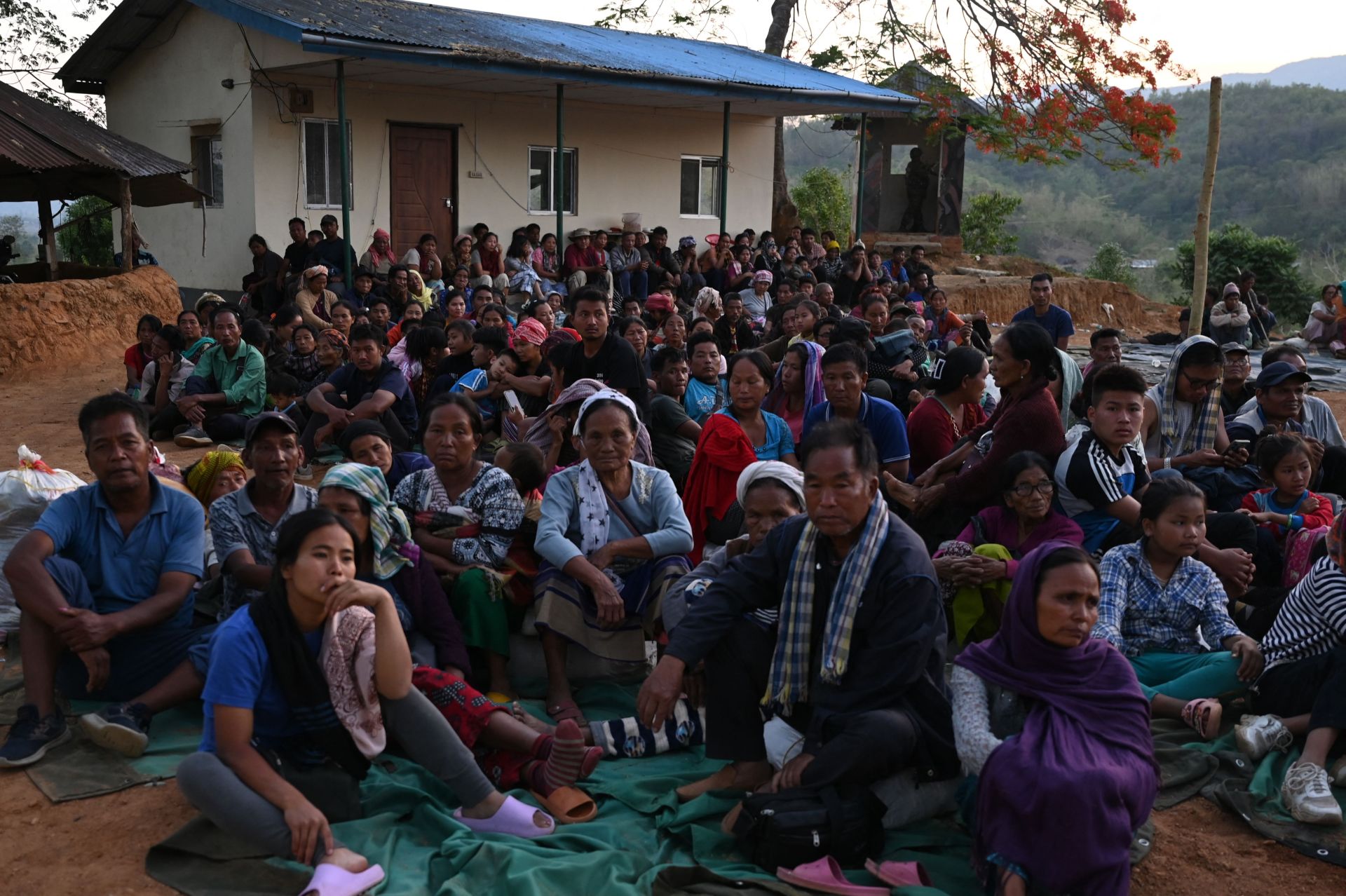At the same time that Indian Prime Minister Narendra Modi, senior ministers and the national media focused their attention and energies on the high-profile elections in the southern Indian state of Karnataka — which the ruling Bharatiya Janata Party (BJP) eventually lost — intense ethnic clashes took place in the easternmost corner of India.
Since early May, in India’s state of Manipur, a deadly conflict between native Hindu Meiteis living in the valley and predominantly Christian tribals in the hill districts has claimed more than 60 lives. Hundreds have been hospitalized, over 35,000 have been displaced and 30 churches have been burned down in the valley. People are either living in army camps or have fled the state, prompting the BJP-led state government to announce “shoot on sight” orders to curb the bloodletting.
India’s northeastern region, made up of eight states, is connected with — or rather disconnected from — the mainland by the Siliguri corridor, a sliver of Indian territory also known as the Chicken’s Neck, pinched between neighboring Nepal, Bhutan and Bangladesh. Manipur, a former princely state made up of a vast valley surrounded by hill ranges, shares contiguous borders and cultures with the states of Mizoram and Nagaland, directly next to Myanmar. It has had a troubled history with the Indian government. Its king, Maharaja Bodhchandra Singh, was forced to join the Union of India in 1949, and secessionist movements in the state date back to the 1960s. The contentious Armed Forces Special Powers Act still applies in the state, giving immunity and unbridled powers to security forces, which is seen by locals as an instrument to integrate Manipur’s culturally diverse communities — particularly the tribes — with mainstream Indian society.
Indian media, centered in the metropolises of Delhi and Mumbai — which notices the northeastern region only when such incidents take place — has nowhere been seen since the recent clashes ensued. It was only regional media, such as East Mojo, that went beyond the state capital of Imphal to give a sense of the realities on the ground. The clashes, which several international media have also tried to make sense of, began after a joint solidarity march in the hill district of Churachandpur by the All Tribal Students Union, a civil society representative group of hill tribes. Soon news of arson at a Kuki war memorial came in, prompting unknown miscreants to set fire to homes in both hill and valley districts.
The group was protesting against the recommendation made by the Manipur High Court in April to include the Meitei community (which makes up the majority in the state and is predominantly Hindu) in the Scheduled Tribes (ST) category. This is a category by means of which the Indian government recognizes historically marginalized tribal communities and provides them with grants and reservations in educational institutes and government jobs.
Who qualifies to be listed as a Scheduled Tribe is not clearly defined in the constitution, but a community’s perceived primitiveness, geographical isolation, shyness and social, educational and economic backwardness are considered to distinguish them from other dominant communities. While ST communities form the majority in northeastern states like Nagaland and Mizoram, in Manipur they comprise less than 40% of the population.
In Manipur, the dominant community of the Meiteis is further split into Hindus and Muslims (also known as Pangals), in addition to a small percentage of Christians. The Hindus adopted Vaishnavism (a sect of Hinduism) and abandoned their Indigenous faith of Sanamahism in the 18th century, and the community has been included in various categories — General, Scheduled Castes or Other Backward Classes — depending on their place in India’s rigid caste hierarchy.
This is why tribal communities have been opposed to the Meiteis’ demand for ST status: They have already been included in two special categories. Moreover, Meiteis have major influence in the state’s politics, holding 40 out of 60 seats in the assembly, and their language, Meitei Lon, is both the official state language and the lingua franca between the diverse communities. While Meiteis make up as much as 60% of the state’s population, the ST community of Kukis — which is at the center of the current clashes — comprises only 16%. The three major communities in Manipur — Meitei, Kuki and Naga (another ST community, constituting 24% of the population) — are spread across the region and also live in the neighboring countries of Bangladesh and Myanmar.
While the recent solidarity marches were held simultaneously in Kuki- and Naga-dominated districts, the spate of attacks has particularly targeted Kuki tribes in the valley. Nagas and their areas have been left untouched. Kham Khan Suan Hausing, a political science professor at the University of Hyderabad, explains that a strategic compromise has been reached between the Nagas and the Meiteis, and the Kukis have been rendered the “other.” “In a particular vision of Manipuri identity, the Nagas and the Meiteis are [strange] bedfellows here,” he said. “So you wouldn’t see the Nagas coming out and endorsing anything the Kukis say.”
This was because of the historically fraught relations between the Nagas and Kukis, who have been at loggerheads since the colonial era. This baggage was carried into the worst of the insurgency years in Manipur, in the 1980s and ’90s, and led to an ethnic clash between the groups in 1992. Relations are also tense with the Meiteis, due to the movement for Greater Nagalim, which aims to create a homeland for ethnic Nagas, who are demanding the Naga-dominated districts in Manipur. But the two have allied with one another in the last few years, for the “ethno-social and political reorganization” of the Indigenous people of the Northeast, as reported by the media.
However, last week, when the Council of Nagalim Churches — a body affiliated with Naga separatist groups — condemned the “use of terrorism by state actors” in a statement, it surprised many. But political analysts, like Hausing, are cautious about their intentions.

The reasons for the clashes between the communities run deeper than their differences over ST status, however. Under a special provision of the Indian constitution, Meiteis are not allowed to purchase land in the hill districts of Manipur. There are limits to land ownership and resources that have been reserved for the Scheduled Tribes, and land in the hills is larger than that in the valley, where Meiteis are dominant. Moreover, the increasing settlement and success of the tribals since their emancipation due to better access to education, politics and senior administration are seen as a threat to the Meiteis, who have historically held more social and political capital. Furthermore, the ruling BJP is attempting to maintain its stronghold in the region, which was previously under the Indian National Congress’ rule for decades, and is introducing a new form of nativist, majoritarian politics in India’s northeastern region.
In April, the High Court observed that the government had been neglecting the Meitei community’s demand for ST status for a decade. The petitioner, the Meetei (Meitei) Tribe Union, contended that the Meitei were recognized as a tribe by the colonial British administration before the accession of the state in 1949. After the Indian constitution came into force in 1950, the petitioner said they were not given “tribal” status in the first census of independent India in 1951.
In that 1951 census, R. B. Vaghaiwalla, the Superintendent of Census Operations in Assam, Tripura and Manipur, noted that the British political agent Colonel McCulloch had identified Meiteis as one of the four main tribes originally living in the valley. According to “credible traditions,” McCulloch noted that the Meiteis eventually subdued all the other tribes, emerged as the dominant community and claimed a “Western and Hindu descent.” (Here “western” pertains to the geography of India, where the regions west of the northeast are Hindu-dominated.)
In precolonial Manipur, tribes like the Kukis were fragmented into self-governed village nations warring against one another, with occasional contact with the Meitei monarchy in the valley. The first mention of the Kukis can be found in the court chronicles of King Taothingmang in the year 264. The Kukis were also cited as allies with other Meitei kings dating back to the third century.
Apart from the historical status of the Meiteis, political experts say the heart of the issue is the portrayal of the Kuki tribes as “not Indigenous.” This is partly due to the Kuki tribal community lacking any historical records like the “puyas’” (comparable to a class of Sanskrit scriptures such as the Puranas) or the court records of Meitei royals. As a result, Kukis, like many tribes in India, rely on colonial records, which can only be traced back to the 1800s.
Hoinehling Sitlhou, a sociology professor at the University of Hyderabad who has extensively studied colonial ethnography in India’s northeast, argues that the Kukis have been around as long as the Meiteis. “The missionary history itself is proof of their Indigeneity if you look at the mission records of Presbyterians who came from Mizoram (or the Lushei Hills),” she says. The only difference, she notes, is that, since the tribals practiced shifting cultivation (as they continue to do even today), they moved around the hill ranges searching for fertile plots and were not settled long enough to have title to a portion of land.
The Meiteis and Kukis are also clashing over their recollection of the autonomy that the self-governed hill tribals exercised in precolonial times under the Kangleipak monarchy. Even after the state became a protectorate under the British, following the Anglo-Burmese War in 1826, the hills were administered separately from the valley. This is supported in the accounts of political agents who relied on messengers, known as “Lambu” or “Dobashi” (which means a bilingual speaker), to administer the hills, because of difficulty in accessing the terrain as well as tribal hostility. A 1961 census survey noted that, well after India’s independence, Lambus were still responsible for publicizing government policies in remote areas, indicating the tribes’ remoteness.
“They (Meiteis) changed the narrative by saying that the hills were also a part of the monarchy but it wasn’t like that. We always had a different civility and culture,” said Sitlhou.
Recent years have seen a shift in Indigenous identity politics. “Primitiveness” is often seen as a natural way to define Indigenous identity among those who don’t claim to be aboriginal, or original inhabitants, argues the Indian-origin anthropologist Manvir Singh. But this notion has emerged from the lens of white colonial settlers, he says. “Even if you are not aboriginal, you can count as Indigenous if you come across as simple, egalitarian, culturally encapsulated, spiritually attuned to nature, and somehow isolated from history and civilization,” he wrote in the New Yorker. This has been the lens adopted by the Indian government in understanding communities as tribes in order to include them in the protected list, and it is the argument that the Kukis and other tribes in Manipur have employed against the inclusion of Meiteis in the ST list.

Political developments in the neighboring country of Myanmar have also led to an “otherization” of the Kuki tribes in Manipur. After the military coup in Myanmar in February 2021, refugees began pouring into the tribal hill districts from the bordering Chin state because they share ethnic kinship with the Kukis. Over 50,000 refugees have taken shelter in the neighboring state of Mizoram.
Unlike Mizoram, which sheltered refugees against the central directive, Manipur’s BJP-run government ordered their people to “politely turn them away,” since India does not have a policy on refugees and is not a signatory to relevant international agreements. Nevertheless, Kuki civil society groups surreptitiously hosted refugees. This became an impetus for the narrative that there are “illegal” Kuki residents in Manipur. Although Manipur’s Chief Minister Biren Singh told East Mojo that he was ready to welcome any civilians from Myanmar, his government detained the refugees, planning to deport them as soon as the situation improved.
If that wasn’t enough, another narrative emerged, also endorsed by the chief minister, to the effect that the hill tribes are poppy cultivators, blaming them for the illegal drug trade in the state and making them a target for the government’s “war against drugs” campaign. T. S. Haokip, a former rural development professional and consultant to the Indian government, explained that poor villagers gravitate to poppy cultivation in the pursuit of easy money. “Instead of planting cabbages or other vegetables, poppy gives good returns. When government schemes don’t reach them, this was the best option for them to build a home and send their kids to good schools,” he told New Lines. While the practice spread widely in the hill areas, Haokip said it would be wrong to label Kukis as poppy cultivators, since only a fraction of them are engaged in the activity. Due to this incorrect labeling, the government has been evicting Kuki tribes from reserved forest areas — even though they are legally recognized as “traditional forest dwellers” — accusing them of illegal occupation and destroying the forests.
Biren Singh’s push to invoke Indigenous religious symbols as a way to revive Sanamahism (practiced by only 8% of Meiteis) and the designation of tribal land in the hills as sacred protected sites for the Meiteis because they are mentioned in older scriptures have also been seen as threats by the Kukis. Hence, the latter feel isolated and attacked from different corners. “This is a potent mix of religion (Sanamahism) and politics, as a ruse to snatch away tribal lands, and the same kind of mixing of politics with religion came into full play in the courtroom last month,” says Hausing.
Moreover, when three churches in the valley were razed to the ground due to “lack of proper permits” last month, it was interpreted by the tribal community at large as an affront to their culture and religion.
The narrative against the Kukis is mixed and comprises several issues, from conservation to migration, comments Ram Wangkheirakpam, an Imphal-based environmental activist. The issues of so-called refugees and poppy cultivation, coupled with the general ignorance of people about protecting reserved forests and conservation, have led to this violence, he asserts. “Yes, poppy planting is bad, but then study why people are doing it and what their livelihood options are. Instead, the approach has been violent, like sending police and armies to cut down fields,” Wangkheirakpam told New Lines. “If you want to protect the land, then you have to rehabilitate the people.”
Cumulatively, this hysteria in Manipur has led to a growing demand for a National Register of Citizens, similar to the one prepared in the neighboring state of Assam in 2019. The exercise was meant to identify “genuine citizens” and is based on documents and family tree verifications against the perceived threat of illegal Bangladeshis. But it excluded 1.9 million applicants, leaving them in legal limbo, and led to large-scale bureaucratic and legal harassment, as well as the death of up to 30 persons in detention centers, not including several others who died by suicide. If this registry were allowed in Manipur, it could be disastrous because, in this state, people in tribal communities are not as well documented as their valley counterparts.
Political observers like Hausing say that supporting the demand for ST status for the Meiteis and backing the narrative that their land and resources are under threat by “illegal” immigrant Kukis have been used to bring dissidents in line and gain populist support. He argues that these actions have become the “preparatory stage of an institutionalized riot system.” Moreover, the burning of churches was a deliberate political ploy to win sympathy from the Hindu majority in mainland India. “You have civil society organizations who are increasingly considering themselves as Indigenous in juxtaposition with Kuki refugees and illegal encroachers or immigrants,” he told New Lines. “But the undercurrent in all this is land ownership. It is a community’s greed for land.”
Hausing’s analysis resonates with what Manvir Singh, the anthropologist, warns about politics built around Indigeneity that seeks to “justify why their ethnic group, and not another, deserves particular resources and accommodations.” This justification is then used to weaken domestic ties, which are particularly critical for oppressed minorities. Most worrying, according to Manvir Singh, is the fact that the rhetoric of Indigeneity can have an even grimmer result: “co-option by far-right nationalists.” Manipur, a state with a troubled history in the easternmost corner of India, is bearing witness to this phenomenon.
Sign up to our mailing list to receive our stories in your inbox.



